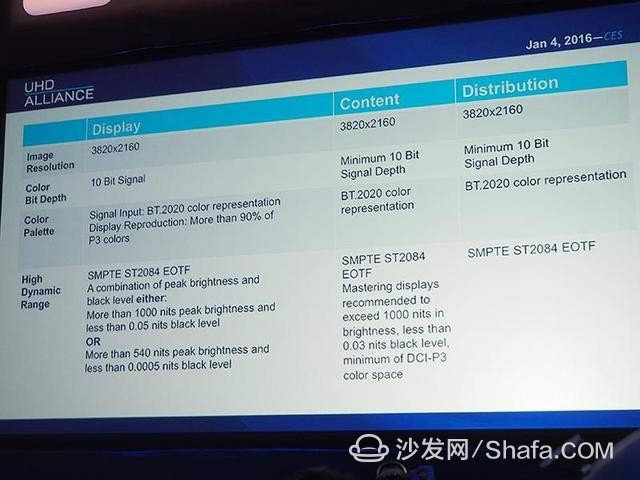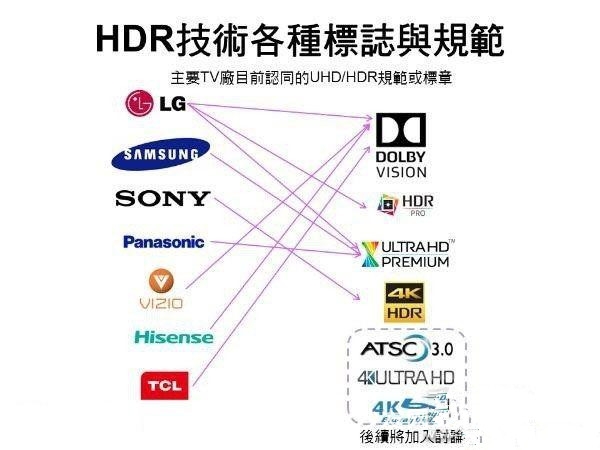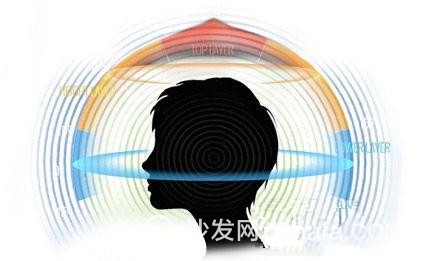Don't be fooled. Real 4K HDR Ultra HD is not so simple

This year, the UltraHD Premium certification has entered the field of vision for the first time and won the support of leading international TV manufacturers and industry leading companies. It has become the new standard for 4K Ultra HD. What is the use of the standard? The standard is to allow consumers to no longer be fooled, so that consumers can afford to buy real enjoyment. Then take a look at the real 4K HDR Ultra HD standard.
What is 4K?
4K is a range of resolution, ie 4096×2160 pixel resolution, which is generally used for professional equipment. Current home-use devices, such as 4K TV, 4K monitor, 4K projector, and even 4K Blu-ray disc, have a resolution of 3840x2160. The 2K resolution is a pixel resolution of 2048x1080. The resolutions of high-definition televisions, high-definition displays, projectors, and blue light are all basically 1920x1080 pixel resolution.

What is the 4K UltraHD Premium Certification Standard?
This year's CES, UltraHD Premium certification for the first time entered the field of vision, supporting UltraHD Premium certification is not only TV manufacturers such as LG, Samsung, Panasonic, Sony, more Warner Bros., 20th Century Fox, Universal Hollywood studios such as this , as well as standards-setting technology companies such as Dolby, DTS, and content operators such as DIRECTTV and Netflix.
Therefore, do not think that UltraHD Premium is just a certification, it also represents a content industry chain in the era of 4K HDR, and a collection of producers in multiple industry chains. Strictly speaking, UltraHD Premium is not a standard, but it does have its own set of requirements in order to regulate the HDR ecological chain.
At present, UltraHD Premium is only provided for devices such as monitors and TVs for authentication. Its requirements for devices are as follows:
1. Resolution: 3840×2160 pixels2. Color depth: 10bit
3. Signal input: support BT.2020 (Note that the current TV products can not completely cover the BT.2020 color gamut range, here only the support for BT.2020 signal input)
4. Color gamut: greater than 90% DCI-P3 color space
5.HDR: High dynamic range image electro-optical conversion that supports SMPTE ST2084 EOTF
6. Brightness dynamic range: (1) Brightness over 1000 nits/black level below 0.05 nits (mainly for LCD); (2) Brightness above 540 nits/black level below 0.0005 nits (mainly for OLED)

What is HDR? What surprises does it have?
HDR stands for High-Dynamic Range, which is a high-dynamic-range image technology. Before this technology was applied to photography, we often heard that enabling HDR during the shooting process can make the original dark scene brighter and more transparent. This technology has been applied to home television.
The range of brightness that traditional TVs can exhibit is extremely limited, and is far from the range that human eyes can perceive. The reason is that the brightness of the traditional TV in the bright picture can not be put up, and the dark place will not come down. Caused by the human eye is ultimately perceived as a poor sense of the level of the picture, a large number of details are lost. HDR super display technology is to solve this problem came into being.

The actual performance of HDR, the picture shows the Sony HDR technology
The core of TV HDR technology is to improve the brightness of the screen and control the brightness of the dark part of the screen, thereby enhancing the contrast between the dark and bright images; the HDR technology brings the visual quality enhancement is intuitive, even ordinary viewers can use the naked eye to identify Therefore, many manufacturers have adopted HDR technology on television products this year.

HDR display technology manifestations
For HDR, the most important thing is contrast. LCD TVs can exhibit a minimum brightness of 0.1 nits, the brightest is between 500 and 1000 nits, and the contrast ratio is only 5,000 to 1. If you increase the brightness to 1000 nits, you can achieve 10,000 to 1.
Are all HDR technologies the same?
Sony: Self-developed [4K HDR]
LG: Third Party [DOLBY VISION], [HDR PRO] and [ULTRAHD PREMIUM]
Samsung: Third Party ã€ULTRAHD PREMIUM】
Panasonic: Third Party ã€ULTRAHD PREMIUM】
VIZIO: Third Party [DOLBY VISION]
Hisense: Third Party [DOLBY VISION]
TCL: Third Party [DOLBY VISION]

In addition to HDR, what are the other important indicators? What do they mean?
The five dimensions of 4K UltraHD Blu-ray are: resolution, color depth, color gamut, contrast, and number of frames. The resolution is 4K, which is 3840x2160 pixels, the color depth is 10bit, the color gamut is BT.2020, the contrast is HDR, and the frame number is 60 frames (60p).

In addition to HDR and 4K resolution and 60p frame number, the color depth and color gamut of these two indicators we do not understand, then the following to explain.
For example, this is:

On the left is the 8bit effect, the color transition is not uniform, the color gradation is very clear, and the right 10bit effect color transition smooth, rich and full color, the effect is very good.
In addition, the panel of the TV or the display is not required to be 10 bits, and it is only required to support 10 bits of input and output.
Color gamut: BT.2020 color space
The widely-known wide-gamut TV in the market is actually using the wide color gamut technology, which enables the color gamut to exceed the BT.709 standard to display more colors.
The above picture clearly informs BT.2020 of the color space range, which is not known to be several times higher than the original BT.709.
Here, UltraHD Premium does not require a device such as a TV or monitor to be a panel that supports BT.2020 output. Note that this is a panel, and only the TV or monitor is required to support the BT.2020 input.
What is immersive audio?

The reason why I didn't speak about panoramic sounds is because Dolby is the only one that actually uses the term panoramic sound. It's more than the Dolbys who actually do immersive audio.
Into the 4K era, immersive audio has begun to enter everyone's attention. The development of imaging technology is far more rapid and direct experience than the development of audio technology. From the original 3D to the current 4K, HDR, and high dynamic frame rates (48 frames, 60 frames, 120 frames), etc. Is a very intuitive experience.
Dolby Atmos

Dolby Panorama breaks through the traditional concept of 5.1 and 7.1 channels, and can combine the content of the movie to present dynamic sound effects. Through the role of the top speakers, the audience is surrounded and real 3D sound effects are achieved, for example, in the past. In our home theater, the 5.1 or 7.1 sound effects are flat. The aircraft flies through the air, rain drops from the top to the bottom, and is achieved through these flat audio devices, from top to bottom or from bottom to top. The sound effects are not particularly prominent and the positioning is not particularly precise.
DTS:X

DTS:X is an open-end, new-generation codec standard. It is also an object-based multidimensional spatial audio technology (hereinafter referred to as MDA). As with the other two immersive sound effects, all three dimensional sound effects are achieved through multidimensional positioning.
Currently, the first partner to integrate DTS:X technology is GDC, which is the exclusive certification agent for DTS:X in Asia. They started in May 2015 and provided DTS:X technology upgrades to their existing 40,000 cinema servers. Domestic cinemas have not yet taken any action.

Unlike Dolby Atmos and Auro-3D, which has strict requirements for the layout of speakers in the room, DTS:X is very flexible in this respect. There is no special speaker placement requirement. You can configure the speakers according to the room and your preferences. In theory, since DTS:X belongs to the sound object technology recording, the more complete the layout of the speakers in the entire room, the richer the details presented by the DTS:X sound effects.
4K era has officially come, 4K hardware prices civilians, 4K equipment is also rapidly entering the homes of ordinary people. 4K resources are also increasing. However, the products of various manufacturers are also mixed. If you really want to enjoy the shocking images brought by 4K Ultra HD and HDR, instead of spending money to buy Fudge, you must understand these key indicators of 4K.
Smart TV/box information can focus on smart TV information network sofa butler (http://), China's influential TV box and smart TV website, providing information, communication, etc. on TV boxes, smart TVs, smart TV software, etc. Answering questions.
Cylinder Assembly,Cylinder Assembly Tubular,Cylinder Head Assembly,Clutch Master Cylinder Assembly
Chongqing LDJM Engine Parts Center , https://www.ckcummins.com
